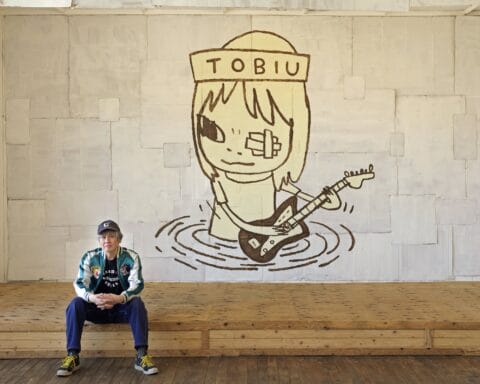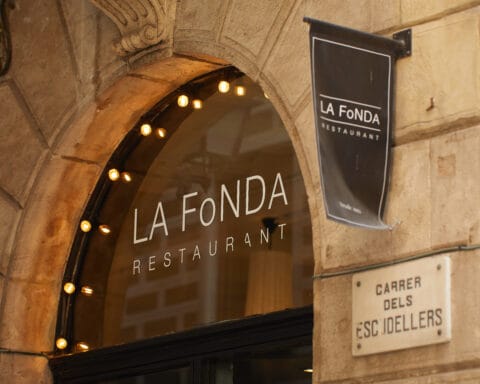Lisbon, the capital of Portugal, is a city of vibrant colors, rich history, and an ever-evolving artistic scene. While its stunning architecture and historical sites are well-known, Lisbon’s street art has recently gained international recognition, transforming the city into an open-air gallery. This guide will take you through the most iconic, hidden, and must-see street art locations across Lisbon, giving you a detailed look at where to find the city’s best murals, graffiti, and urban installations.

A Brief History of Street Art in Lisbon
Street art in Lisbon began as a form of expression during the political and social upheavals of the late 20th century. Following the Carnation Revolution in 1974, which ended nearly five decades of dictatorship, the streets of Lisbon became a canvas for voices that had long been suppressed. In the 1980s and 1990s, graffiti culture, influenced by New York City’s hip-hop scene, began to take root. Over time, this evolved into a more sophisticated and varied form of street art, with murals and large-scale installations appearing across the city.
Today, Lisbon’s street art scene is celebrated worldwide, with both local and international artists contributing to the city’s ever-changing urban landscape. The city government has even embraced this art form, commissioning works to revitalize neighborhoods and creating dedicated spaces for street artists.
1. LX Factory: A Hub of Creative Energy
Located in the Alcântara neighborhood, LX Factory is a former industrial complex that has been transformed into a cultural and creative hub. It’s one of the most iconic spots for street art in Lisbon. As soon as you enter the gates, you are greeted by a vibrant explosion of colors and creativity.
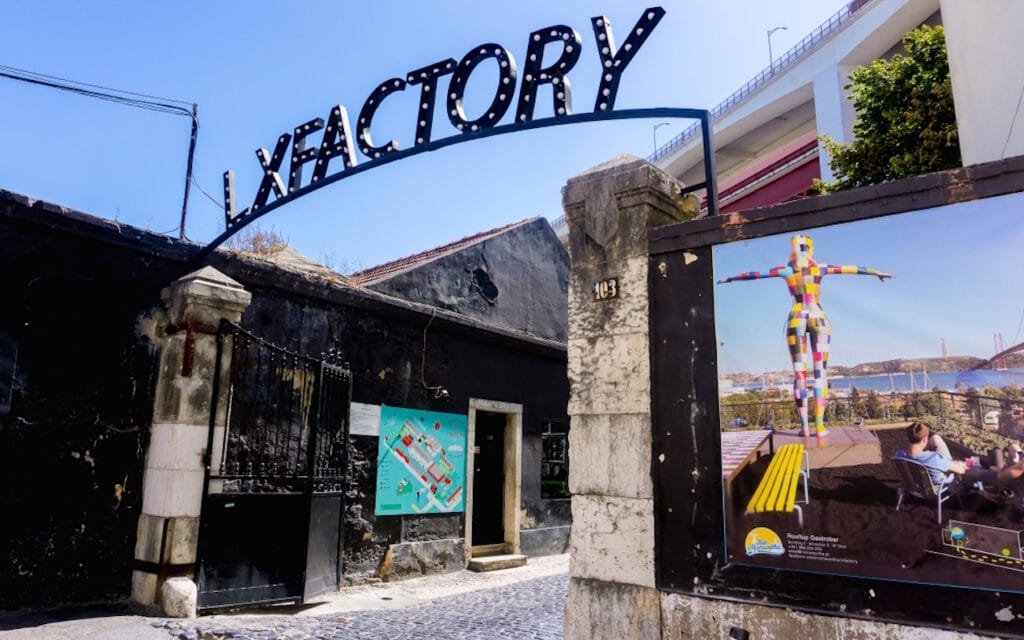



Key Pieces to Look For:
- Shepard Fairey’s Mural: One of the most famous murals at LX Factory is by Shepard Fairey, the American artist behind the iconic “OBEY” series and the Barack Obama “Hope” poster. This piece blends Fairey’s distinct style with Lisbon’s local flavor, featuring intricate patterns and powerful political messages.
- Bordalo II’s Trash Animals: Bordalo II, a Lisbon-born artist known for creating animals out of trash, has several pieces scattered throughout LX Factory. His work is not just visually striking but also carries a strong environmental message, highlighting the impact of waste on wildlife.
- Pantonio’s Fluid Figures: Look for the flowing, almost aquatic figures painted by Portuguese artist Pantonio. His work often features blues and blacks, with dynamic lines that give the impression of movement.
Exploring LX Factory:
LX Factory is more than just a place to see street art; it’s a creative space filled with shops, restaurants, and galleries. Take your time to explore the area, as new works are constantly being added. The walls, floors, and even rooftops are canvases, so keep your eyes peeled for art in unexpected places.
2. Calçada da Glória: The Open-Air Gallery
Calçada da Glória, a steep street leading from Restauradores Square to Bairro Alto, is one of Lisbon’s most accessible spots for street art. This location is famous for its “Galeria de Arte Urbana” (Urban Art Gallery), an initiative by the Lisbon City Council to turn this historic street into an evolving canvas.

Key Pieces to Look For:
- The Tribute to Amália Rodrigues: One of the standout pieces in this gallery is a mural dedicated to Amália Rodrigues, the Queen of Fado. The portrait is beautifully detailed, capturing her melancholic expression and paying homage to her lasting impact on Portuguese culture.
- Collaborative Wall: The walls along Calçada da Glória are frequently repainted by various artists, so every visit might offer something new. Look out for the collaborative murals where multiple artists contribute their styles, creating a patchwork of different aesthetics.
Exploring Calçada da Glória:
The best way to experience Calçada da Glória is to take the funicular up and then walk back down, allowing you to take in the art at your own pace. The vibrant colors contrast beautifully with the old stone walls, making it a perfect spot for photography.
3. Amoreiras Wall of Fame: The Epicenter of Graffiti Culture
Located near the Amoreiras Shopping Center, the “Amoreiras Wall of Fame” is one of the most important locations for graffiti in Lisbon. This long wall, stretching along the Avenida Engenheiro Duarte Pacheco, has been a legal graffiti zone for years, attracting both established artists and newcomers.
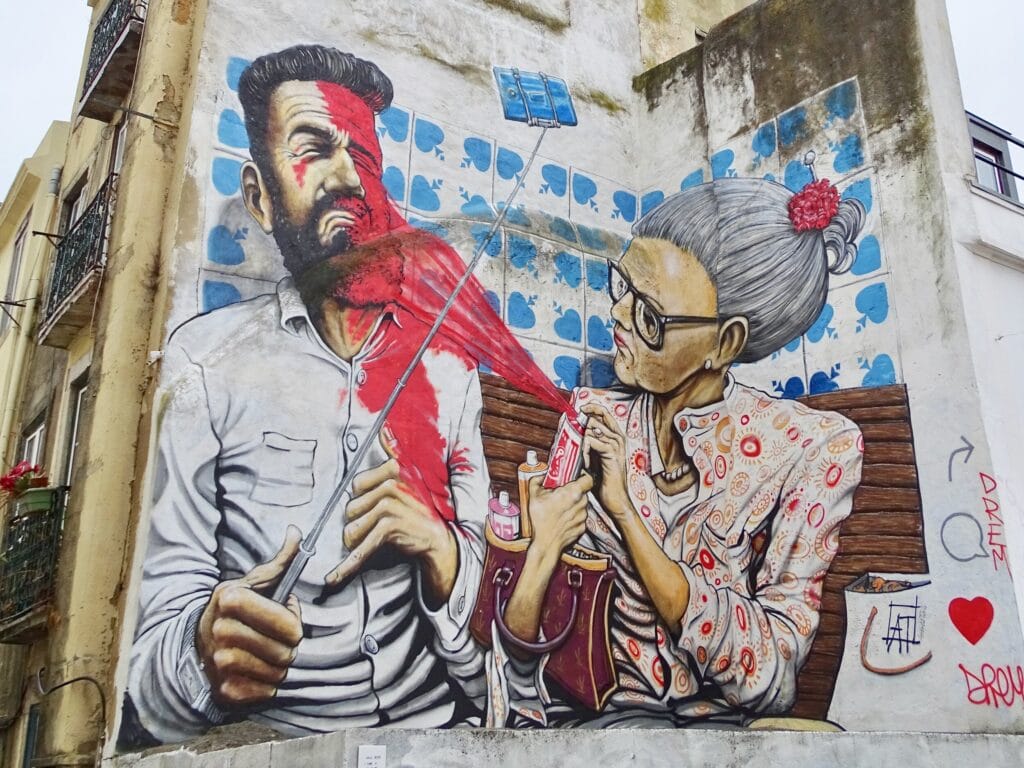

Key Pieces to Look For:
- OS GEMEOS Collaboration: The famous Brazilian twins, OS GEMEOS, have left their mark on this wall with a colorful, surreal piece that blends their signature style with Portuguese motifs. Their work is often playful, featuring whimsical characters and vibrant colors.
- Vhils’ Debut: Before Vhils became a global street art sensation, he created some of his first works on the Amoreiras Wall. Look for his signature technique of carving faces into walls, a method that has earned him international acclaim.
- Youth Culture Represented: The Amoreiras Wall is a hotspot for younger, up-and-coming artists to showcase their work. The pieces here often reflect the current social and political climate, making it a constantly evolving snapshot of youth culture in Lisbon.
Exploring the Amoreiras Wall:
The wall is best explored on foot, allowing you to take in the sheer scale of the art. Start at the top and walk down, paying attention to how different sections of the wall reflect various styles and techniques. Since it’s a legal graffiti wall, the art here changes frequently, so it’s worth revisiting.
4. Quinta do Mocho: A Living Museum of Urban Art
Quinta do Mocho, located in the northern suburbs of Lisbon, is often overlooked by tourists but is one of the most impressive street art sites in the city. This residential area has been transformed into an open-air gallery, with over 100 large-scale murals covering the facades of apartment buildings.
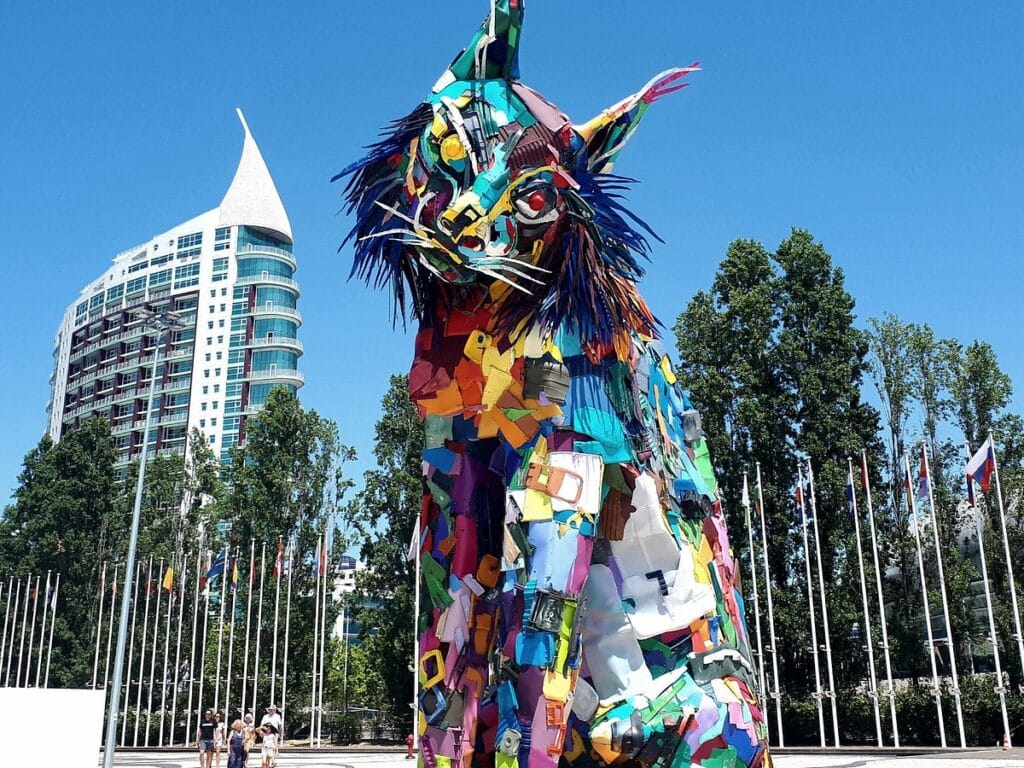

Key Pieces to Look For:
- Tamara Alves’ “The Forest”: This mural, by Portuguese artist Tamara Alves, is a striking depiction of a woman intertwined with forest elements. It’s a beautiful example of how street art can transform an urban environment into something magical.
- Smile: A large mural by Brazilian artist Smile, which features a colorful portrait of a child’s face. The expressive eyes and vibrant colors make this piece stand out among the other murals in the area.
- Mural by Vhils: Vhils has also left his mark on Quinta do Mocho with a powerful portrait carved into the wall of one of the buildings. The detail in the work is astounding, with the face seemingly emerging from the concrete.
Exploring Quinta do Mocho:
The best way to experience Quinta do Mocho is by taking a guided tour. Local guides, often residents of the neighborhood, offer insights into the stories behind the murals and the transformation of the area. This is a great way to understand the social impact of street art in Lisbon.
5. Alfama: Where Tradition Meets Urban Expression
Alfama, Lisbon’s oldest neighborhood, is known for its narrow streets, historic buildings, and traditional Fado music. But it’s also home to some remarkable street art, blending the old and the new in a way that reflects Lisbon’s evolving identity.

Key Pieces to Look For:
- Fado-Inspired Murals: Alfama’s street art often pays homage to the neighborhood’s Fado heritage. Look for murals depicting famous Fado singers, musical instruments, and scenes of traditional Portuguese life.
- Mário Belém’s “Lisbon’s Heart”: A beautiful piece by Mário Belém, this mural captures the spirit of Lisbon with its colorful depiction of a heart intertwined with symbols of the city, including trams, tiles, and the river.
- The Fish Series by Mistik: Scattered throughout Alfama, you’ll find a series of playful, colorful fish by the artist Mistik. These pieces add a whimsical touch to the historic streets, reflecting Alfama’s close connection to the Tagus River.
Exploring Alfama:
Alfama is best explored on foot, wandering through its labyrinthine streets. Start at the Miradouro de Santa Luzia, where you’ll find some beautiful tiles and murals, then make your way down through the neighborhood, keeping an eye out for hidden gems. Alfama’s mix of history and contemporary art makes it one of the most unique places to experience street art in Lisbon.
6. Marvila: The New Street Art District
Marvila, an industrial district on the eastern edge of Lisbon, is quickly becoming one of the city’s most exciting areas for street art. The neighborhood has undergone significant regeneration in recent years, with artists transforming abandoned warehouses and factories into vibrant canvases.

Key Pieces to Look For:
- Akacorleone’s “Face to Face”: This large mural by Portuguese artist Akacorleone is one of the most eye-catching pieces in Marvila. The work features two stylized faces with vibrant colors and geometric patterns, reflecting the artist’s background in illustration and graphic design.
- Add Fuel’s Azulejo-Inspired Work: Add Fuel is known for his contemporary take on traditional Portuguese tiles (azulejos). His work in Marvila features intricate patterns that blend the old and the new, creating a dialogue between Portugal’s past and present.
- Underdogs Gallery Murals: The Underdogs Gallery, founded by street artist Vhils, is at the heart of Marvila’s street art scene. The exterior of the gallery is covered in murals by various artists, and the surrounding area features numerous other works that have been commissioned or supported by the gallery.
Exploring Marvila:
Marvila is a bit off the beaten path, so it’s less crowded than other parts of Lisbon. This makes it a great place to explore at your own pace. Start at the Underdogs Gallery, where you can also see exhibitions of contemporary urban art, and then wander through the surrounding streets to discover the many murals that adorn this up-and-coming neighborhood.
7. Cais do Sodré: The Heart of Lisbon’s Nightlife and Street Art
Cais do Sodré is known for its nightlife, with bars and clubs lining the streets. But it’s also a hotspot for street art, especially around the iconic Pink Street (Rua Nova do Carvalho). This area’s vibrant art scene reflects its eclectic mix of old and new Lisbon.

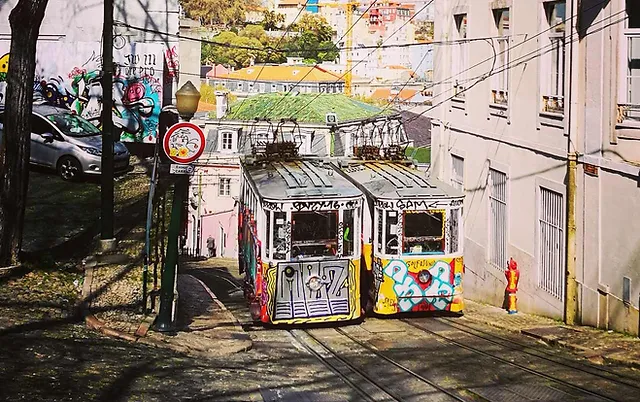
Key Pieces to Look For:
- The Pink Street Murals: The Pink Street itself is a work of art, with the entire road painted in a bright pink hue. Along the sides, you’ll find murals that range from abstract designs to detailed portraits, all contributing to the street’s unique atmosphere.
- Rodrigo Branco’s Portraits: Brazilian artist Rodrigo Branco has left his mark on Cais do Sodré with a series of expressive portraits. His work often explores themes of identity and memory, using bold colors and abstract forms.
- Various Installations Around Time Out Market: Around the Time Out Market and the adjacent streets, you’ll find various street art pieces, including murals, stencils, and installations. This area is a melting pot of styles, reflecting the diversity of Lisbon’s street art scene.
Exploring Cais do Sodré:
Cais do Sodré is best explored in the late afternoon or early evening when the area starts to come alive. Start at the Pink Street and then wander through the surrounding streets, taking in the art as you go. The combination of vibrant street art and lively nightlife makes this one of the most dynamic areas of Lisbon.
8. Belém: Historical Landmarks and Modern Art
Belém is one of Lisbon’s most historic neighborhoods, home to landmarks like the Jerónimos Monastery and the Belém Tower. But it’s also a site for modern street art, with several pieces that juxtapose the old with the new.
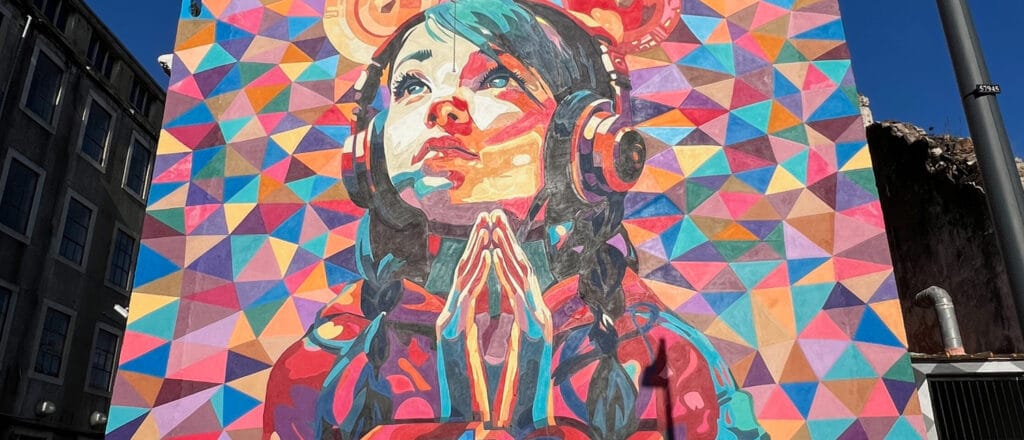
Key Pieces to Look For:
- Vhils’ Portrait of Marielle Franco: Near the MAAT (Museum of Art, Architecture, and Technology), you’ll find a powerful mural by Vhils dedicated to Marielle Franco, the Brazilian politician and human rights activist. The piece is carved into the wall, creating a hauntingly beautiful tribute.
- Shepard Fairey’s “Revolutions” Mural: Another piece near the MAAT is by Shepard Fairey, titled “Revolutions.” This mural features Fairey’s characteristic style, combining bold colors and political messaging with imagery that resonates with Lisbon’s revolutionary past.
- Various Works Around the MAAT: The area around the MAAT has become a hotspot for street art, with several large murals and smaller pieces scattered throughout. The contrast between the modern art and the historic surroundings creates a unique atmosphere.
Exploring Belém:
Start your visit at the MAAT, where you can see both the museum’s exhibitions and the surrounding street art. From there, take a walk along the waterfront towards the Belém Tower, keeping an eye out for murals and other pieces along the way. The mix of history and modern art makes Belém a fascinating area to explore.
9. Intendente: A Cultural Melting Pot
Intendente is one of Lisbon’s most culturally diverse neighborhoods, known for its vibrant street life and eclectic mix of cultures. It’s also a place where street art flourishes, with many walls and buildings covered in colorful murals.

Key Pieces to Look For:
- Sam3’s Silhouettes: Spanish artist Sam3 has created several large-scale murals in Intendente, featuring his signature black silhouettes. These pieces are both simple and profound, often depicting human figures in dynamic poses.
- VHILS in Largo do Intendente: Vhils has a prominent piece in Largo do Intendente, a central square in the neighborhood. The mural, carved into the wall, depicts a local resident, highlighting the connection between the art and the community.
- Diversity of Styles: Intendente is home to a wide range of street art styles, from traditional graffiti to abstract murals and political statements. This diversity reflects the neighborhood’s cultural mix, making it a dynamic and ever-changing canvas.
Exploring Intendente:
Intendente is best explored on foot, starting at Largo do Intendente. From there, wander through the surrounding streets, taking in the mix of street art, local shops, and cafes. The area’s vibrant atmosphere and diverse art make it a must-see for anyone interested in Lisbon’s street art scene.
10. Graça: Street Art with a View
Graça, located on one of Lisbon’s highest hills, offers some of the best views of the city. It’s also a hotspot for street art, with murals that are as impressive as the panoramic vistas.


Key Pieces to Look For:
- The Graça Lion by Kobra: Brazilian artist Eduardo Kobra’s mural of a lion, located near the Miradouro da Senhora do Monte, is one of the most iconic pieces in Graça. The colorful, geometric design contrasts beautifully with the historic surroundings.
- C215’s Portraits: French street artist C215 has created several portraits throughout Graça, often featuring local residents. His detailed, stencil-based style adds a human element to the neighborhood’s street art scene.
- Murals by RAM: Portuguese artist RAM has several pieces in Graça, featuring his characteristic surreal and fantastical elements. His work often explores themes of nature, mythology, and the human psyche.
Exploring Graça:
Start your visit at the Miradouro da Senhora do Monte, where you can enjoy a stunning view of the city before exploring the surrounding streets. Graça’s street art is spread throughout the neighborhood, so take your time to discover the various murals and smaller pieces. The combination of art and breathtaking views makes Graça a unique destination for street art lovers.
11. Parque das Nações: Modern Art in a Futuristic Setting
Parque das Nações, Lisbon’s modern waterfront district, is known for its futuristic architecture and expansive public spaces. It’s also home to some striking street art, often reflecting the area’s contemporary vibe.

Key Pieces to Look For:
- VHILS’ “Rua da Cintura” Murals: Vhils has several pieces in Parque das Nações, including a series of portraits carved into the walls along Rua da Cintura. These works explore themes of identity and urbanization, fitting well with the district’s modern feel.
- Os Gêmeos’ Futuristic Mural: Near the Oriente Station, you’ll find a mural by Brazilian duo Os Gêmeos, featuring their signature whimsical characters. The piece blends perfectly with the futuristic architecture of the area.
- Public Art Installations: In addition to murals, Parque das Nações features several public art installations, including sculptures and interactive pieces. These works contribute to the district’s overall artistic atmosphere.
Exploring Parque das Nações:
Parque das Nações is a vast area, so it’s best to explore it by bike or on foot. Start at Oriente Station and make your way towards the waterfront, stopping to admire the various street art pieces along the way. The district’s mix of modern art and architecture makes it a unique part of Lisbon’s street art scene.
Conclusion: Lisbon as a Living Canvas
Lisbon’s street art scene is as diverse and dynamic as the city itself. From the historic neighborhoods of Alfama and Graça to the modern districts of Parque das Nações and Marvila, street art has become an integral part of the urban landscape. Each area offers something unique, reflecting the cultural, social, and historical context of the neighborhood.

Whether you’re a dedicated street art enthusiast or just a curious traveler, Lisbon’s open-air galleries provide endless opportunities for exploration and inspiration. As you wander through the city’s streets, you’ll discover that Lisbon is more than just a place to visit—it’s a living canvas, constantly evolving and revealing new layers of creativity and expression


